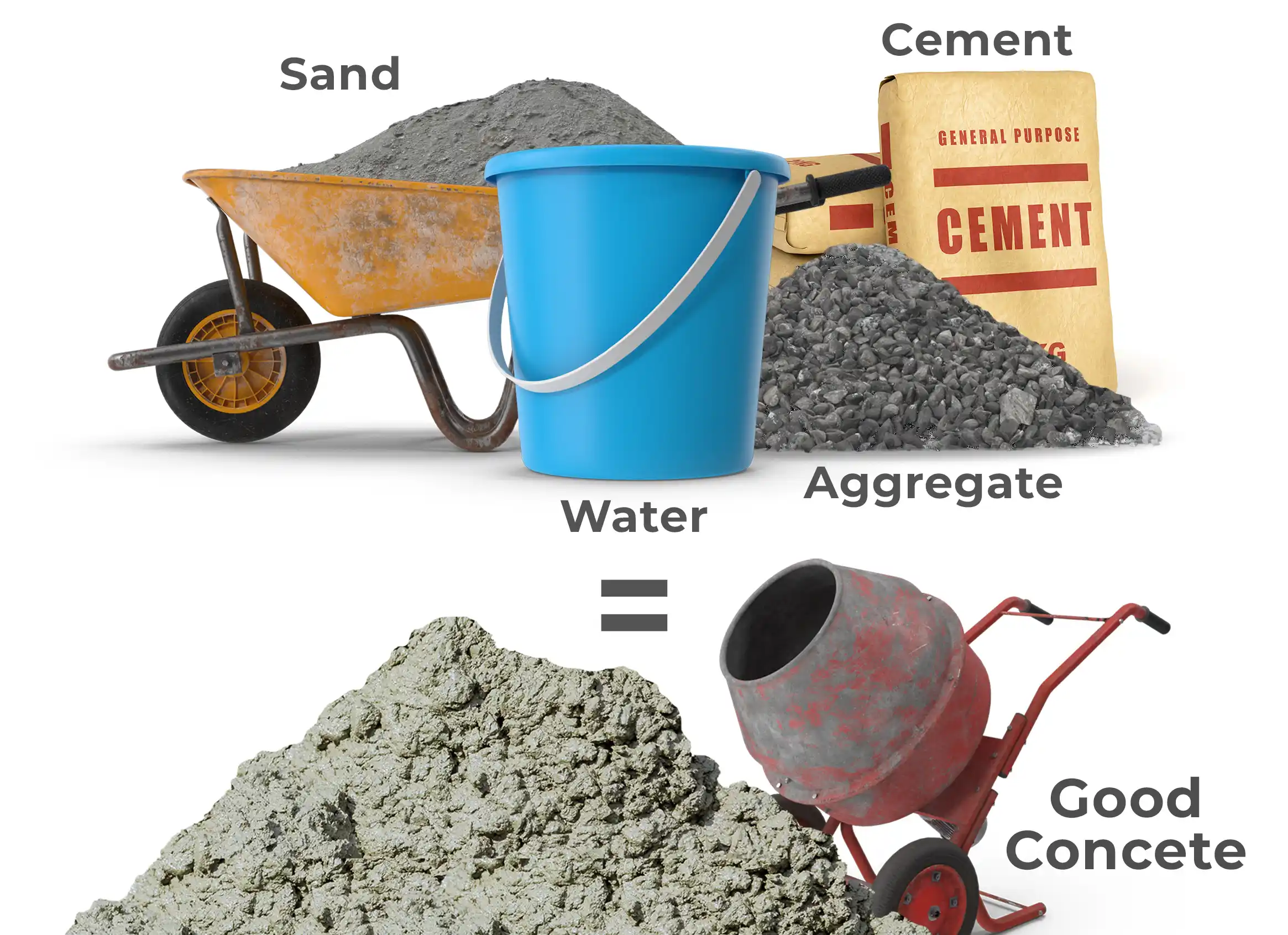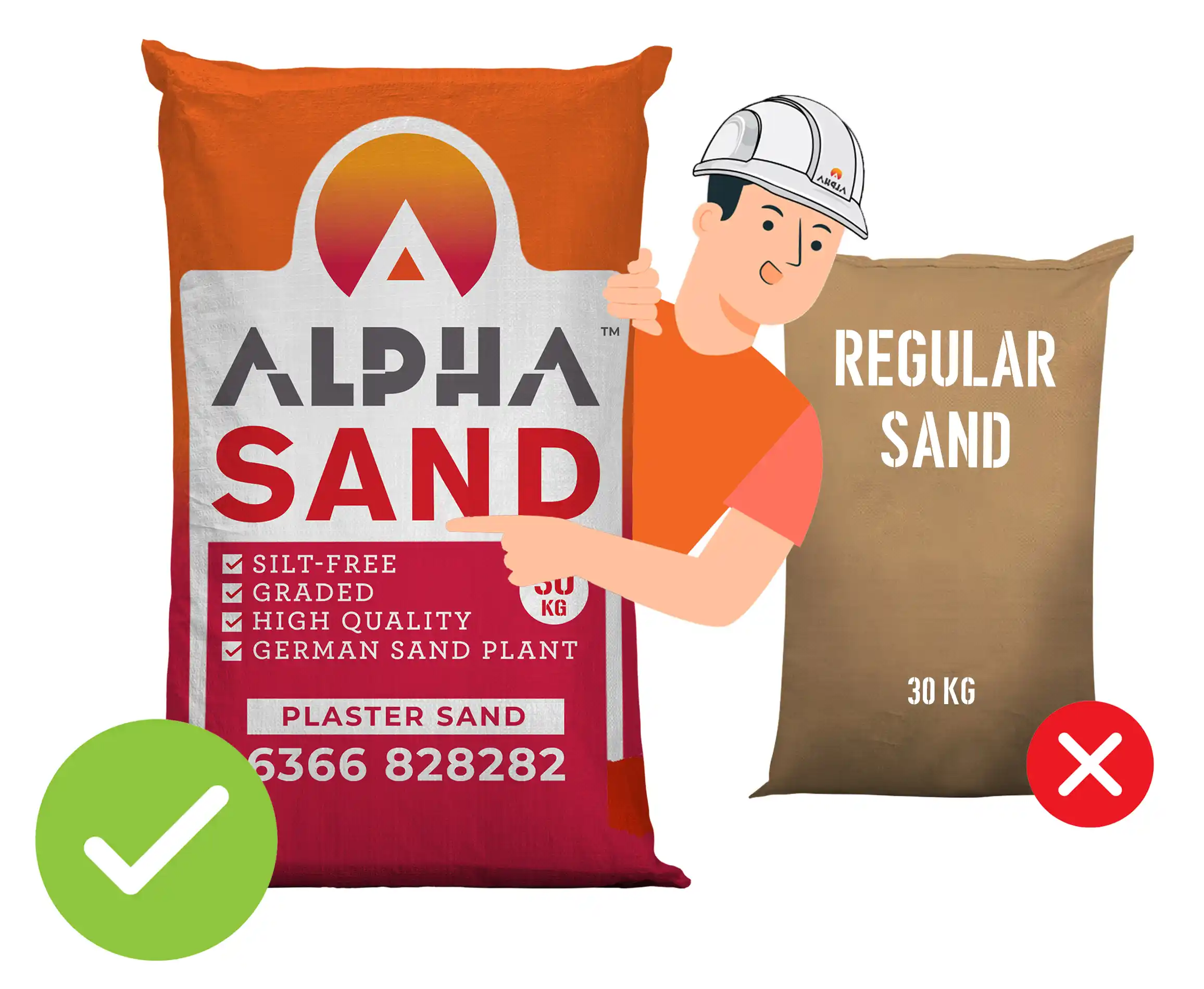
Does the quality of sand matter in concreting? Yes, just like the quality and quantity of cement play a major role, the quality of sand matters when it comes to concreting. You might wonder why sand is important in the concrete mix, especially when people generally focus on good quality cement and Steel for constructing sturdy and durable homes. However, the importance of sand should not be overlooked because it’s what actually strengthens the concrete.
Click on the below button for a free one-on-one consultation to immediately select the right raw materials for your home.
Table of Contents:
What is Concrete?
Importance of Sand in Concrete Mix:
What kind of sand should be used in concrete Mix?
Where to Buy Best Concrete Sand in Bangalore?
Conclusion:
Frequently Asked Questions:
Let's start the article by understanding what is concrete.
What is Concrete?

Concrete is a primary construction material that is made from a mixture of three important materials: cement, sand, and water. Cement works as the binding agent, holding other materials together to create a cohesive substance, so it is very important to use quality sand.
Sand, particularly concrete sand, is added to enhance the concrete's overall strength. Conversely, water initiates a chemical reaction with the cement known as hydration, causing the mixture to transform from a semi-liquid state to a solid structure.
The process of manufacturing concrete starts by combining the components in specified proportions, i.e., 1 : 1.5 : 3 : 0.5 (Cement : Fine Aggregate : Coarse Aggregate : Water), to get the required strength.

As it progresses, the water-cement reaction continues, leading to the hardening of the mixture. Concrete’s strength and durability come from this transformation. As a result of the interconnection of the cement particles, the solid mass can bear significant loads and withstand environmental pressures.
Concrete is widely used in construction. It serves as a strong foundation for building, as a matter of fact, not only for building but also for bridges, roads, and damns. Concrete’s ability to withstand factors like weather, fire, etc, further contributes to its usage in construction.
I hope you have a brief knowledge of concrete. Now, let us understand the importance of sand in concrete.
Importance of Sand in Concrete Mix:

Strength and Structural Integrity:
Sand is a filler material in concrete, adding strength and stability to the overall structure. The sand particles' size, shape, and grading affect the concrete mix's strength. Better particle packing is achieved with well-graded sand, improving interlocking between aggregate particles and a denser concrete matrix. This increases the compressive and flexural strength of the concrete, improving its structural integrity.
Workability and Cohesion:
Sand significantly impacts the workability and cohesion of the concrete mix. Sand particles fill the gaps between larger aggregates, allowing for better concrete distribution and compaction. The right amount of sand in the mix improves workability, making placement, molding, and finishing easier. It aids in creating a smooth and consistent surface, lowering the likelihood of voids or honeycombing.
Water Demand and Cement Paste:
The proportion of sand in the concrete mix influences the amount of water and cement paste required. Sand particles provide a surface area where the cement paste can bind, resulting in a cohesive mixture. A proper sand-to-cement ratio reduces water demand, resulting in a more cost-effective and environmentally friendly concrete mix. It also aids in the control of the hardened concrete's shrinkage and cracking tendencies.
Durability and Permeability:
Sand increases the durability of concrete by making it more resistant to environmental factors. Well-graded sand reduces concrete permeability, limiting the passage of moisture, aggressive chemicals, and harmful substances into the structure. This improves long-term durability by lowering the likelihood of corrosion, deterioration, and structural damage.
Aesthetic Considerations:
In addition to its functional properties, sand selection can influence concrete aesthetics. To achieve desired visual effects or specific architectural requirements, various types of sand, such as natural sand, crushed sand, or colored sand, can be used. The texture, color, and appearance of the sand all impact the overall appearance and feel of the finished concrete surfaces.
Particle Size Distribution and Packing Density:
Sand particle size distribution significantly impacts the concrete's packing density and overall strength. A variety of particle sizes in well-graded sand allows for better packing, resulting in a denser concrete matrix. Properly packed particles reduce voids, increasing concrete strength and structural integrity. The optimal particle size distribution ensures efficient particle packing, which improves the mixture's overall performance.
Workability and Consistency:
Sand significantly impacts the workability and consistency of the concrete mix. It lubricates particles, allowing for easy mixing, placing, and finishing. The right amount of sand adds to the desired workability, allowing the concrete to be molded and shaped as needed during construction. The consistency of the mix allows for the uniform distribution of cement paste, aggregates, and other components, resulting in a homogeneous and cohesive material.
Internal Cohesion and Bonding:
Sand is an essential component that improves the internal cohesion and bonding of the concrete mixture. Sand particle surface texture and shape create contact points for the cement paste, allowing for solid adhesion and interlocking. This cohesive bond strengthens the concrete's tensile and compressive strength, increasing its ability to withstand loads and stresses.
Shrinkage Control and Dimensional Stability:
The presence of sand in the concrete mix aids in shrinkage control and reduces the risk of cracking. Shrinkage may occur as the concrete cures and hardens. Properly graded sand helps reduce overall volume change by providing internal support, preventing excessive shrinkage, and minimizing crack formation. This contributes to the concrete structure's dimensional stability and long-term durability.
Environmental Considerations:
Environmental factors should be considered when selecting sand for concrete mixtures. Using locally sourced sand, reducing transportation distances, and considering the ecological impact of sand extraction are all examples of sustainable construction practices. Sand sourced responsibly helps to minimize environmental degradation, preserve natural resources, and reduce carbon emissions from transportation.
Permeability and Drainage:
Sand in concrete reduces its permeability and drainage properties. Sand that has been appropriately graded allows for controlled water flow through the concrete, allowing for adequate drainage and lowering the risk of water accumulation. This property is critical in pavements, where proper drainage prevents water damage and extends the structure's life.
What Kind of Sand Should Be Used in Concrete Mix?

The type of sand commonly used in concrete mixes is known as concrete sand or C sand. This type of sand is specifically chosen for its particle size, shape, and texture, which contribute to the concrete's overall strength, workability, and durability. It typically has angular grains that interlock well, providing better cohesion within the mixture. Concrete sand helps create a strong bond between the cement and aggregates, resulting in a robust and reliable final concrete product.
Where to Buy Best Concrete Sand in Bangalore?

Get the finest quality concrete sand from Alpha Sand – your trusted sand and concrete block manufacturing company. Our commitment to customer satisfaction is paramount, as evidenced by our personalized live demonstrations that provide comprehensive understanding.
Experience the added advantage of our free consultation services – make an informed choice today. Click here to access expert guidance and make the right decision for your construction needs.
Conclusion:
Sand is a critical component of concrete mixtures, influencing their strength, workability, durability, and performance. Construction professionals can create concrete mixtures that meet the specific requirements of each project by understanding the importance of sand and considering factors such as particle size distribution, workability, bonding, and environmental considerations. Structures with enhanced strength, durability, and overall quality can be built with careful sand selection and proportioning, ensuring longevity and satisfaction for years.
Frequently Asked Questions:
What is the Role of Sand in Concrete?
Sand's role in concrete is to add bulk, strength, and cohesion to the mixture, improving workability and lowering shrinkage.
How Does Sand Affect Concrete?
Sand influences concrete by improving its strength, workability, and durability. It fills voids between larger aggregate particles, improves cement paste bonding, controls shrinkage, and influences the overall density and permeability of the concrete.
What is the Purpose of Sand?
Sand in concrete serves as a fine aggregate, filling the spaces between larger aggregates and providing the mixture with the necessary support and cohesion.
What Are The Functions of Sand in a Concrete Mix?
Sand in a mix serves two purposes: it improves workability by reducing particle friction and increases the concrete's overall strength and structural integrity.